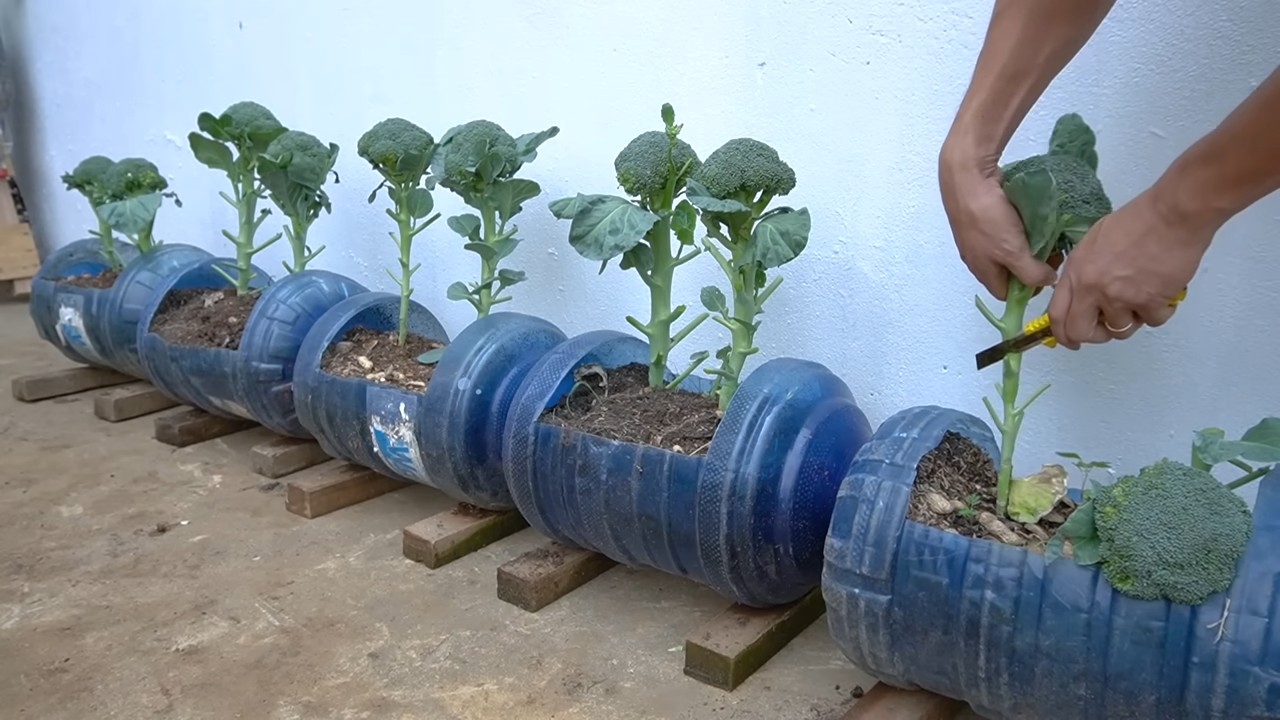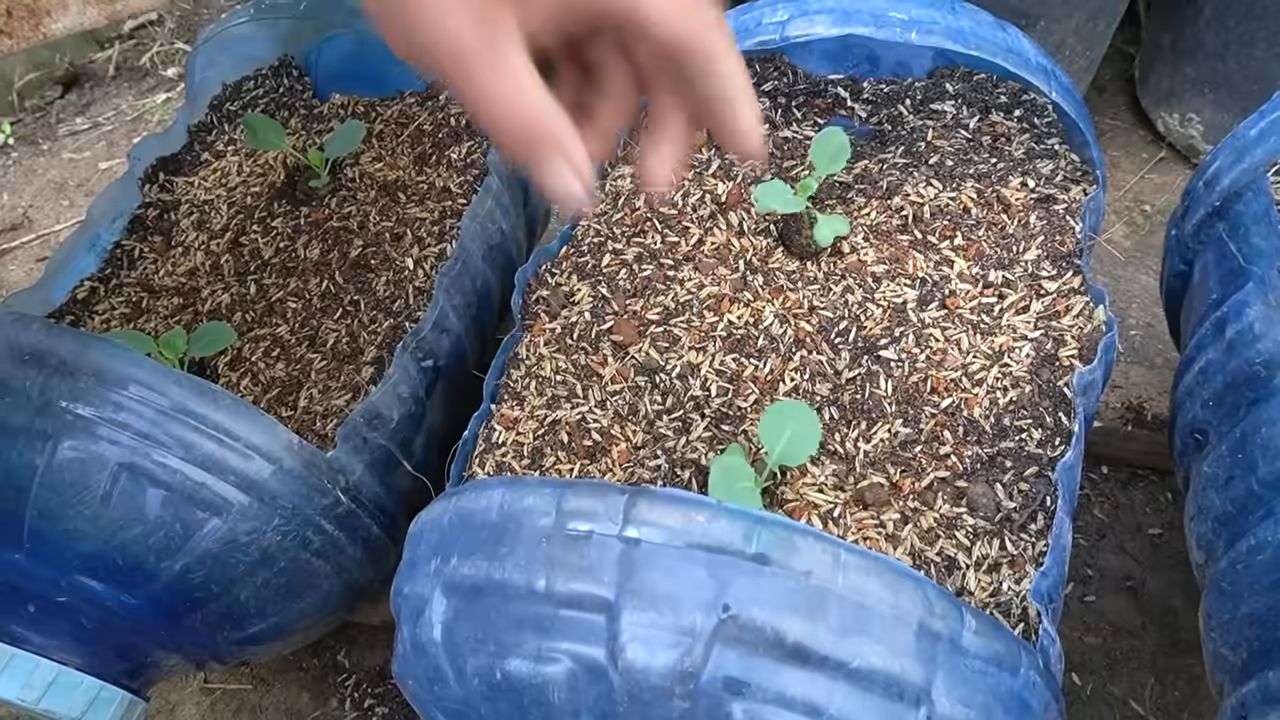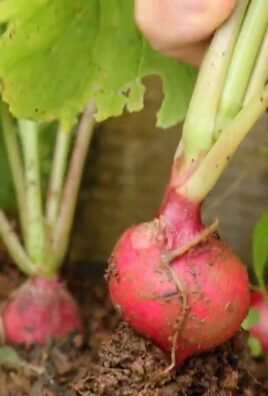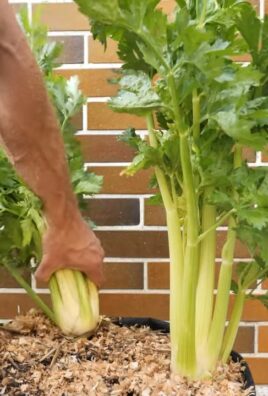Growing Broccoli at Home can seem daunting, but trust me, it’s more rewarding than you might think! Imagine stepping into your backyard and harvesting your own fresh, vibrant broccoli – the taste is simply unmatched compared to store-bought varieties. For centuries, broccoli has been a staple in Mediterranean diets, prized for its nutritional benefits and unique flavor. From ancient Roman gardens to modern-day vegetable patches, this cruciferous veggie has stood the test of time.
But let’s be honest, sometimes the idea of starting a garden feels overwhelming. Where do you even begin? That’s where this DIY guide comes in! I’m going to share some simple, effective tricks and hacks that will make growing broccoli at home a breeze, even if you’re a complete beginner. We’ll cover everything from choosing the right seeds and preparing your soil to protecting your precious plants from pests and diseases. No more expensive grocery store trips for subpar broccoli – get ready to enjoy the satisfaction of growing your own healthy, delicious crop!

Growing Broccoli at Home: A DIY Guide for Beginners
Hey there, fellow gardening enthusiasts! Ever dreamt of harvesting your own crisp, green broccoli heads right from your backyard? Well, dream no more! Growing broccoli at home is totally achievable, even if you’re a complete beginner. I’m going to walk you through everything you need to know, from choosing the right variety to dealing with pesky pests. Let’s get our hands dirty!
Choosing Your Broccoli Variety
First things first, let’s talk broccoli varieties. There are tons to choose from, and the best one for you will depend on your climate and personal preferences. Here are a few popular options:
* ‘Waltham 29’: A classic, reliable variety that produces large, tight heads. It’s a great all-around choice.
* ‘DiCicco’: This variety is known for its early maturity and production of smaller, side shoots after the main head is harvested. More broccoli for you!
* ‘Green Magic’: A heat-tolerant variety, perfect for warmer climates. It produces uniform, dark green heads.
* ‘Romanesco’: If you’re feeling adventurous, try Romanesco! It’s a visually stunning variety with fractal florets and a slightly nutty flavor.
Consider your local climate and growing season when making your choice. Check seed packets for specific recommendations.
Starting Your Broccoli Seeds
You can either start your broccoli seeds indoors or directly sow them in your garden. I personally prefer starting them indoors, as it gives them a head start and protects them from early-season pests.
Starting Seeds Indoors
1. Gather Your Supplies: You’ll need seed starting trays or small pots, seed starting mix, broccoli seeds, a spray bottle, and a grow light (optional, but highly recommended).
2. Prepare Your Seed Starting Trays: Fill your trays or pots with seed starting mix. Gently tap them to settle the mix.
3. Sow Your Seeds: Make a small indentation (about ¼ inch deep) in the center of each cell or pot. Place 2-3 broccoli seeds in each indentation. Cover the seeds with a thin layer of seed starting mix.
4. Water Gently: Use a spray bottle to gently moisten the soil. Avoid overwatering, as this can lead to damping off (a fungal disease that kills seedlings).
5. Provide Light and Warmth: Place your seed starting trays in a warm location (around 70-75°F). If you’re using a grow light, position it a few inches above the trays. If not, place them in a sunny window.
6. Keep the Soil Moist: Check the soil moisture daily and water as needed to keep it consistently moist, but not soggy.
7. Thin Seedlings: Once your seedlings have emerged and have a couple of true leaves (the second set of leaves), thin them to one seedling per cell or pot. Choose the strongest, healthiest-looking seedling and snip off the others at the soil line.
8. Harden Off Seedlings: About a week before you plan to transplant your seedlings outdoors, you’ll need to harden them off. This process gradually acclimates them to outdoor conditions. Start by placing them outdoors in a sheltered location for a few hours each day, gradually increasing the amount of time they spend outside.
Direct Sowing Seeds
1. Prepare Your Garden Bed: Choose a sunny location with well-drained soil. Amend the soil with compost or other organic matter to improve its fertility and drainage.
2. Sow Your Seeds: Sow your broccoli seeds directly into the soil, about ½ inch deep and 1-2 inches apart.
3. Water Gently: Water the soil gently to moisten it.
4. Thin Seedlings: Once your seedlings have emerged and have a couple of true leaves, thin them to the strongest seedlings, spacing them about 18-24 inches apart.
Transplanting Your Broccoli Seedlings
Once your seedlings are about 4-6 weeks old and have been hardened off, it’s time to transplant them into your garden.
1. Prepare Your Garden Bed: Choose a sunny location with well-drained soil. Broccoli needs at least 6 hours of sunlight per day. Amend the soil with compost or other organic matter to improve its fertility and drainage.
2. Dig Holes: Dig holes that are slightly larger than the root balls of your seedlings, spacing them about 18-24 inches apart.
3. Transplant Seedlings: Gently remove the seedlings from their trays or pots. Loosen the roots slightly and place the seedlings in the holes.
4. Backfill with Soil: Fill the holes with soil, gently firming it around the base of the seedlings.
5. Water Thoroughly: Water the seedlings thoroughly after transplanting.
6. Mulch: Apply a layer of mulch around the plants to help retain moisture, suppress weeds, and regulate soil temperature.
Caring for Your Broccoli Plants
Now that your broccoli plants are in the ground, it’s time to give them the care they need to thrive.
* Watering: Broccoli needs consistent moisture, especially during head formation. Water deeply and regularly, especially during dry periods. Aim for about 1-1.5 inches of water per week.
* Fertilizing: Broccoli is a heavy feeder, so it needs regular fertilization. Apply a balanced fertilizer (e.g., 10-10-10) every 2-3 weeks. You can also side-dress with compost or other organic matter.
* Weeding: Keep your garden bed free of weeds, as they can compete with your broccoli plants for nutrients and water.
* Pest Control: Broccoli is susceptible to several pests, including cabbage worms, aphids, and flea beetles. I’ll cover pest control in more detail below.
* Support: If your broccoli plants get top-heavy, you may need to provide them with support. You can use stakes or tomato cages to keep them upright.
Dealing with Pests and Diseases
Unfortunately, broccoli is a magnet for pests. But don’t worry, there are plenty of ways to protect your plants!
* Cabbage Worms: These green caterpillars can quickly devour your broccoli leaves. Handpicking them off the plants is an effective method, especially for small infestations. You can also use Bacillus thuringiensis (Bt), a natural bacterium that kills caterpillars.
* Aphids: These tiny insects suck the sap from plants, causing them to weaken and distort. Spraying your plants with a strong stream of water can dislodge aphids. You can also use insecticidal soap or neem oil.
* Flea Beetles: These tiny beetles jump when disturbed and can create small holes in your broccoli leaves. Covering your plants with row covers can prevent flea beetles from reaching them. You can also use insecticidal soap or diatomaceous earth.
* Clubroot: This fungal disease causes swollen, distorted roots and can stunt plant growth. To prevent clubroot, plant broccoli in well-drained soil and avoid planting it in the same location year after year. If you suspect clubroot, remove infected plants and dispose of them properly.
Regularly inspect your plants for signs of pests or diseases. Early detection and treatment are key to preventing serious problems.
Harvesting Your Broccoli
The moment you’ve been waiting for! Broccoli is typically ready to harvest 50-80 days after transplanting, depending on the variety.
1. Check the Head: The main head should be firm, tight, and dark green. The individual florets should be tightly closed.
2. Cut the Head: Use a sharp knife to cut the head from the plant, leaving about 5-6 inches of stem.
3. Encourage Side Shoots: After harvesting the main head, your broccoli plant will often produce smaller side shoots. These can be harvested as they mature.
4. Store Your Broccoli: Store your freshly harvested broccoli in the refrigerator for up to a week.
Enjoying Your Homegrown Broccoli
Congratulations! You’ve successfully grown your own broccoli. Now it’s time to enjoy the fruits (or rather, vegetables) of your labor. Broccoli can be eaten raw, steamed, roasted, stir-fried, or added to soups and stews. Get creative and experiment with different recipes!
Here are a few of my favorite ways to enjoy homegrown broccoli:
* Steamed Broccoli with Lemon and Garlic: A simple and healthy side dish.
* Roasted Broccoli with Parmesan Cheese: Roasting brings out the natural sweetness of broccoli.
* Broccoli and Cheddar Soup: A comforting and creamy soup.
* Broccoli Salad with Cranberries and Almonds: A refreshing and flavorful salad.
Growing broccoli at home is a rewarding experience. With a little bit of effort and patience, you can enjoy fresh, delicious broccoli all season long. Happy gardening!

Conclusion
So, there you have it! Growing broccoli at home, while it might seem daunting at first, is an incredibly rewarding experience. It’s a journey that connects you directly to your food, offering a level of freshness and flavor you simply can’t replicate with store-bought options. Forget those bland, often wilted heads from the supermarket; imagine biting into crisp, vibrant green florets, bursting with nutrients and the unmistakable taste of homegrown goodness.
This isn’t just about saving a few dollars at the grocery store; it’s about embracing a more sustainable lifestyle, reducing your carbon footprint, and gaining a deeper appreciation for the natural world. Plus, let’s be honest, there’s a certain satisfaction that comes from nurturing a tiny seed into a thriving plant that provides you with delicious, healthy food.
But the benefits extend beyond the practical. Gardening, in general, is a fantastic stress reliever. The simple act of tending to your plants, feeling the soil between your fingers, and watching them grow can be incredibly therapeutic. And when you’re growing your own broccoli, you’re also ensuring that you’re consuming a product free from harmful pesticides and herbicides. You have complete control over what goes into your garden, allowing you to prioritize organic and sustainable practices.
Why is growing broccoli at home a must-try? Because it offers a superior product, a connection to nature, a healthier lifestyle, and a sense of accomplishment all rolled into one.
Now, let’s talk about variations. While we’ve focused on the basics of growing broccoli, there’s plenty of room for experimentation. Consider trying different varieties of broccoli, such as Calabrese, Romanesco, or sprouting broccoli. Each offers a unique flavor and texture profile. You can also experiment with companion planting, pairing your broccoli with herbs like rosemary or thyme to deter pests and enhance flavor. If space is limited, consider growing broccoli in containers. Just be sure to choose a large enough pot and provide adequate drainage.
Don’t be afraid to get your hands dirty and learn as you go. Gardening is a continuous learning process, and there’s always something new to discover. The most important thing is to start. Even if you only have a small balcony or patio, you can still grow your own broccoli.
We wholeheartedly encourage you to give this DIY trick a try. Start small, be patient, and don’t be discouraged by setbacks. Every gardener faces challenges, but the rewards are well worth the effort. And once you’ve harvested your first head of homegrown broccoli, we’d love to hear about your experience! Share your tips, tricks, and photos in the comments below. Let’s build a community of home gardeners and inspire others to embrace the joy of growing their own food. What are you waiting for? Get planting!
Frequently Asked Questions (FAQ)
What is the best time of year to start growing broccoli?
The ideal time to start growing broccoli depends on your climate. Broccoli is a cool-season crop, meaning it thrives in temperatures between 60°F and 70°F (15°C and 21°C). In most regions, you can plant broccoli in early spring for a summer harvest or in late summer for a fall harvest. For spring planting, start seeds indoors 6-8 weeks before the last expected frost. For fall planting, start seeds outdoors in mid-summer. Check your local frost dates to determine the best planting time for your area. If you live in a region with mild winters, you may even be able to grow broccoli throughout the winter.
How much sunlight does broccoli need?
Broccoli requires at least 6 hours of direct sunlight per day to thrive. Choose a planting location that receives full sun for optimal growth and head development. If you live in a particularly hot climate, some afternoon shade may be beneficial to prevent the plants from bolting (going to seed prematurely). Insufficient sunlight can result in leggy plants with small, underdeveloped heads.
What kind of soil is best for growing broccoli?
Broccoli prefers well-drained, fertile soil with a pH between 6.0 and 7.0. Amend your soil with compost or other organic matter to improve drainage, fertility, and water retention. Broccoli is a heavy feeder, so it’s important to provide it with plenty of nutrients. Consider adding a slow-release fertilizer at planting time or side-dressing with compost tea or fish emulsion throughout the growing season. Avoid planting broccoli in compacted or poorly drained soil, as this can lead to root rot and other problems.
How often should I water my broccoli plants?
Broccoli needs consistent moisture to thrive. Water deeply and regularly, especially during dry periods. Aim to keep the soil consistently moist but not waterlogged. A good rule of thumb is to water when the top inch of soil feels dry to the touch. Mulching around your broccoli plants can help to retain moisture and suppress weeds. Avoid overhead watering, as this can increase the risk of fungal diseases. Instead, water at the base of the plants.
What are some common pests and diseases that affect broccoli?
Broccoli is susceptible to a variety of pests and diseases, including cabbage worms, aphids, flea beetles, clubroot, and downy mildew. Regularly inspect your plants for signs of infestation or disease. Handpick pests whenever possible. Use row covers to protect your plants from insects. Apply organic pesticides, such as Bacillus thuringiensis (Bt), to control cabbage worms. Practice crop rotation to prevent soilborne diseases. Ensure good air circulation to reduce the risk of fungal problems. If you encounter serious pest or disease problems, consult with your local extension office for advice.
How do I know when my broccoli is ready to harvest?
Broccoli is ready to harvest when the central head is firm, compact, and a deep green color. The individual florets should be tightly closed. If the florets start to open and turn yellow, it’s a sign that the broccoli is overripe. Use a sharp knife to cut the head from the plant, leaving a few inches of stem. After harvesting the central head, the plant will often produce smaller side shoots, which can also be harvested.
Can I grow broccoli in containers?
Yes, you can grow broccoli in containers, but you’ll need to choose a large enough pot. A 5-gallon container is generally recommended. Make sure the container has drainage holes to prevent waterlogging. Use a high-quality potting mix and provide regular fertilization. Container-grown broccoli may require more frequent watering than broccoli grown in the ground.
How do I store harvested broccoli?
Store harvested broccoli in the refrigerator. Wrap the head loosely in a damp paper towel and place it in a plastic bag. Broccoli can be stored in the refrigerator for up to a week. For longer storage, you can blanch and freeze broccoli.
What are some ways to use homegrown broccoli?
Homegrown broccoli can be used in a variety of dishes. It can be steamed, roasted, stir-fried, or eaten raw. Add it to salads, soups, casseroles, or pasta dishes. You can also use the stems and leaves of the broccoli plant in soups or stir-fries. Don’t be afraid to experiment and find your favorite ways to enjoy your homegrown broccoli!
Is growing broccoli at home really worth the effort?
Absolutely! While it requires some time and effort, the rewards of growing your own broccoli are well worth it. You’ll enjoy fresher, more flavorful broccoli, save money at the grocery store, and gain a deeper connection to your food. Plus, gardening is a great way to relieve stress and get some exercise. So, give it a try and see for yourself!




Leave a Comment